The French Public Higher Schools of Art
Dijon
Ecole nationale supérieure d’art de Dijon
about
The National Higher School of Art of Dijon is the oldest of the seven national schools found in the region. Beginning as the drawing workshop that the painter François Devosge founded in 1765, it developed both its ties to local communities and its national and international reputation. Situated in part in the 18th century Abbot’s palace, at the very heart of Dijon and by train, one and a half hours from Paris, the school enjoys a privileged geographical situation reinforced by the entry into service of the eastern section of the high speed Rhine-Rhône rail network.
Classes in art history, esthetics and philosophy are part of the programme throughout one’s studies. They are completed by lectures, research and creative workshops, study trips, internships which favor differing approaches to creation. At the same time, students are trained in the production techniques necessary for contemporary expression, from the more traditional (film photography, drawing, painting, screen-printing, sculpture and volume), associating the full range of materials (earth, wood, metal, resin, plastics) including newer technologies (computers, infography and multimedia, sound, digital technologies, network practices).

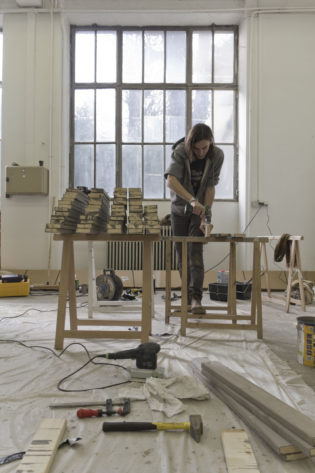
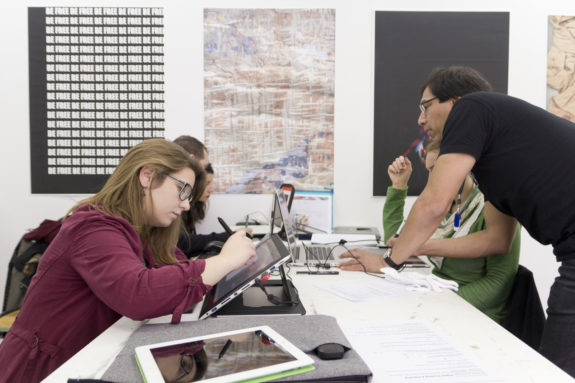

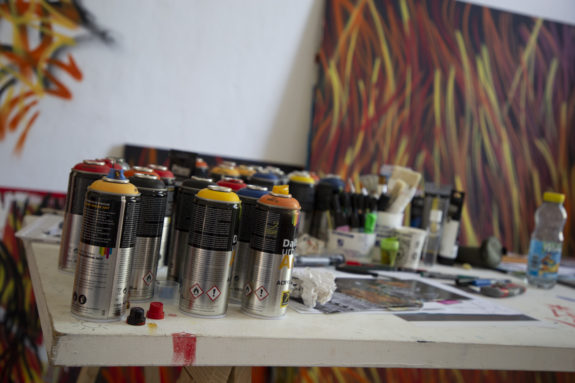
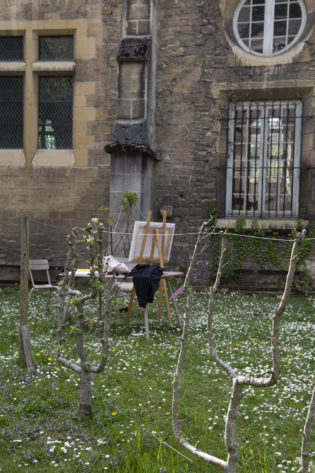


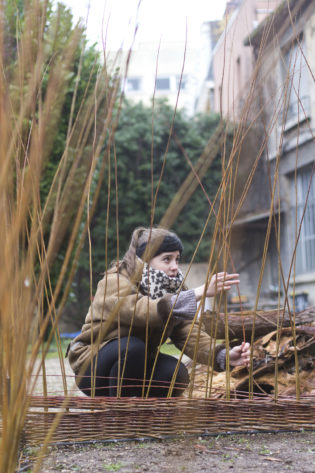

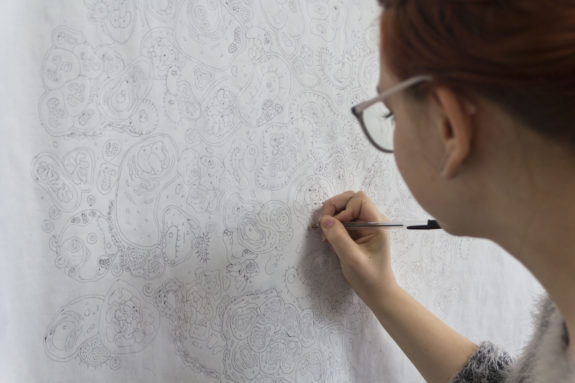

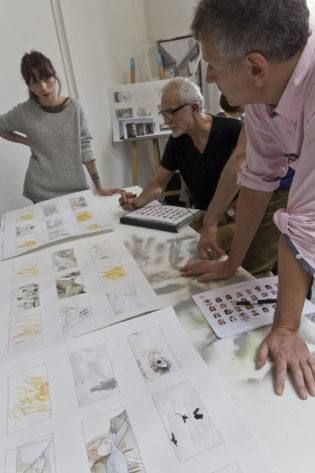
options
//SPECIALISATION IN ART
The Art department accompanies young practitioners throughout their academic experience. Throughout the 5 years of study, they should develop a personal project of art research.
During the first two years, classes focus on essential practices (including drawing, sculpture, installation, sound, performance, image and video). The artists teaching at ENSA provide an interdisciplinary education which seeks to go beyond categories and disciplines so that each student can develop an original and independent project. The aim is to allow students to shape a complex artistic idea which they then implement.
In this sense, the school is a place of resource, experimentation and exchange where knowledge and practice are transmitted and where the student experiences are constructed in common. The wealth of these cultural perspectives affords our school’s graduates multiple professional choices. Students have access to a wide choice of traditional working techniques (such as wood, earth, metal, resin, thermoforming), in addition to the most recent technological resources (like graphic design, 3D, video, sound) and to a theoretical support to frame their contemporary knowledge in historical and multi-disciplinary perspectives. Throughout their studies, students are invited to events outside the school walls letting them be confronted with the reality of collective shows, an introduction to cross-disciplinary projects, to writing critical texts, to visiting construction sites, to encounters with visiting professionals, researchers or residents coming from a scientific background or some other realm. This exposure to diverse experiences makes this specialisation fertile ground for wide-ranging artistic practices.
ENSA Dijon likewise offers greater openness to the outside world, in particular the international stage thanks to its residency programmes and internships covering the USA to China without forgetting the African continent. Internationally renowned artists are increasingly invited by the school to offer students their unique testimony on the diversity of art scenes around the world.
SPECIALISATION IN DESIGN
A multi-faceted training open to what the world is becoming
- L2 and L3 preparation for Bachelor Diploma (DNA): general training in design project, conception and creation at all levels
- M1 and M2 preparation for Masters Diploma (DNSEP): on a topic freely chosen by the student with emphasis on the challenges posed by the world today: ecological transition (ecodesign, biodiversity, attentive to the living), inclusivity (democratic and participative, intergenerational solidarity, gender rights)
Design option in a national school for higher education in art
- Teaching that encourages personal commitment and mutual aid
- Material and human resources of a national school at the service of student projects: small student numbers, international exchanges, audiovisual technology, photography, video, performance and sound art lessons
- A poetic project nourrished by the creative atmosphere of an art school, a significant approach to space, the pleasure of experimentation
- Professional-led training: meetings with professionals, internships, professionalisation classes, partner projects, competitions
- Urban Mutations (MUUR): a Research and Creation workshop (ARC) and research programme: partnerships, workshops, talks, conferences, publications etc.
A training rooted in the real world
- A framework ensured by professionals in design, architecture, scenography, landscape
- Attention paid to current issues: ecodesign, social design, participative projects, tactical urbanism
- Projects in situ in collaboration with actors on the ground: Voies Navigables de France, Greater Dijon, Latitude21, Dijon Opera, Burgundy Theatre, and associations
- Closer international links: student and teacher mobility, cross-workshops, talks and international artist residences
- Speakers, presenters, workshops, visits to exhibitions linked with the themes addressed over the year.
2nd and 3rd year: general training devoted to projectwork
- Project methodology and representation of space (drawing by hand and with 3D software, models and experimentation in volume at different scales
- Continual experimentation using different technologies, materials, processes, theories
- Develop a themed personal project: take part, conceive, represent, complete the project
- Awareness of materials, experimentation and development
- Design at every scale: from object to landscape by way of microarchitecture, public space, interior space, the city, scenography (exhibit, theatre)
- Teaching in design history and theory: from 19th century to today’s issues (ecology and biodiversity, gender and inclusion, digital and participatory)
- Professional immersion: internship lasting 15-30 days.
4th and 5th year: pedagogy centred on the student project
- Personalised support leading to the DNSEP (research thesis and personal project)
- 3-6 months of international mobility and/or professional internship in the 4th year in France or abroad
- Students choose and develop a project on a subject rooted in the contemporary world. In general, the subject should focus on environmental, political and social challenges faced by cities in the 21st century.
qualifications
DNA specialisation in Art
DNA specialisation in Design (Space Design)
DNSEP specialisation in Art
DNSEP specialisation in Design (Space Design)
preparatory schools
A preparatory module is managed by the Conservatoire à Rayonnement Régional.
research units
Art & Society Research Unit (RU)
Created in collaboration with the Maison des Sciences de l’Homme (MSH) at the University of Burgundy, the research unit (RU) ‘Art & Society’ organises all research activities within ENSA Dijon.
With the centres of Pedagogy, Student Life and International Relations, it supplies the support, be it human, material, financial, technical, or institutional, that allows for putting into place research and works towards sharing, valuing and recognising research that takes place in art and design at the heart of the school.
Its members include all of the school’s teachers–artists, designers and theoreticians–who are engaged in research activities in parallel with their teaching duties and their individual and independent professional, artistic, design and theoretical practices. Research thus reflects the artistic media (design, drawing, painting, performance, photography, sound, video, volume, etc.) and forms of knowledge (art history, philosophy, aesthetics, cultural theory) practiced in the school.
Research in art schools: invention, experimentation, sharing
Although art and science–whether human and social sciences, formal sciences (logic, mathematics) and natural sciences (physics, biology, etc.) or engineering sciences–differ in their internal criteria and their own aims, they have never been alien to each other. Research is consubstantial with them, and both constitute activities that are based on the logic of experimentation and invention.
In the course of their history, art and science (and technology) have never ceased to be challenged or even provoked by each other: from geometry, physics or the theory of emotions, yesterday, to contemporary epistemologies stemming from environmental sciences (ecology), digital technologies and their anthropological stakes, such as those of gender studies and postcolonial approaches to theories of culture and domination.
Because the questioning of the forms of restitution of research belongs to the very process of research, and while today, in the scientific world, new forms of approaches and restitution of research are emerging (practice-based-research, etc.), the Research Unit “Research on the environment” is also concerned with the questioning of the forms of restitution of research. While relying on the established academic forms of sharing research results (colloquia, publications), the “Art and Society” Research Unit initiates, encourages and accompanies the invention of new, often hybrid, forms specific to art school research: exhibitions, devices, collective works, etc.
Partner Institutes
- Centre of Action and Research in Contemporary Art in Dijon (ENSA Dijon, The Consortium Art Centre, FRAC Burgundy and Dijon’s Fine Arts Museum)
- The New Patrons for Arts and Sciences (Nouveaux Commanditaires);
- Network of Higher Education in Art;
- Platform of Art Schools in Burgundy Franche-Comté
- Greater Dijon
Scientific partners
- Maison des Sciences de l’Homme (MSH Dijon), University of Burgundy USR CNRS 3516;
- Laboratoire ARTeHIS – Archéologie, Terre, Histoire; CNRS (Institue of Human and Social Sciences and the Institute of Ecology and the Environment), University of Burgundy and the Ministry of Culture and Communication.
- CESAER – Centre of Economics and Applied Sociology in Agricultural and Rural Spaces.
- Agro Institute Dijon, National Institute for Higher Studies in Agricultural Sciences, Food and the Environment
- LIR3S (Laboratoire Interdisciplinaire de Recherche: Sociétes, Sensibilités et Soin (University of Burgundy)
RESEARCH STRUCTURE
The research at the core of the research unit Art & Society is organised around two structural themes, transversal and multi-disciplinary. These axes, which are not mutually exclusive, allow for the identification the domains in which members of the RU situate their research activity.
Axis 1 – Materials,
mediA, intermedialities
This axis questions the relations of media to their own specificity (procedures, methods, histories) and their own identity, as well as to the types of alterities that question them (hybrid forms and translatability of languages; relation of learned forms / popular forms, new technologies; relation of art / culture; autonomy and heteronomy of art; questions around exhibitions).
Axis 2 – Crises,
contexts, combats
This axis addresses the question of art and design in light of their relations with knowledge and power, in as much as they interrogate practices and presentations of visibility and invisibility, eventually generators of violence. In that respect, artistic and design practices cross-reference forms of knowledge and militant practices (ecology, feminism). Hence this particular insistence on the question of inclusion, of place (urban spaces, rural worlds, the margins, migrations), and their contrary (non-places, uprooting etc).
At the core of both axes can be organised one-off events (publication, conferences, exhibition) or even research programmes on a larger scale.
research programmes
Urban Mutations
Headed by: Laurent Matras, Hélène Robert, Leila Toussaint
Linked with: ARC MUUR – Research & Creation Workshop Urban Mutations (headed by Laurent Matras, Hélène Robert, Leila Toussaint)
The transdisciplinary research programme Urban Mutations is an extension of the Bachelor and Masters teaching delivered by the ENSA Dijon Design Option team (studio projects, classes, ARC, workshops). It brings together designers, architects, scenographers, landscape designers, artists and theoricians with all areas mixed up in communal space of thought and imagination, of proposition and urban experimentation strongly rooted in the ecological, political and social realities of cities in the anthropocene age.
Currently humanity is affected by an ecological crisis – pollution, dwindling natural resources, the destruction of ecosystems, the disappearance of biodiversity, climatic warming and disruption, proliferation of extreme episodes of drought and heatwaves – along with the economic, social and political consequences. These force us to radically rethink not only modes of production and consumption but also our way of living and especially living in a city, namely to produce and consume space and time. It questions our use of space and our daily choreographies.
Cities, particularly vulnerable to the effects of environmental crisis, are partly responsible for it. It means that cities can also be the place for local solutions to this global problem.
Design, for a long time confined to the sphere of marketing, today constitutes a collective open to thought, practices and mechanisms at the intersection of research and creation, working, with the same sensory perception (affordance), on the representations and uses of our environment, like vectors to transform urban space.
To think about and know a city as a completely separate ecosystem, to take care of the plant and animal biodiversity it shelters, to promote urban agriculture aimed at alimentary autonomy without endangering the environment, and more globally rethinking the relations between city/nature, that implies also thinking about the activities and socio-economic temporalities of a city. Like slow cities which are spreading all over the world, cities should also incorporate soft mobility (bicycles) and non-carbon ways of moving whose current growth is revealing.
Eco-design thinks about the environmental impact of the materials and forms it implements, extolling low-tech and DIY, self-help and reuse, in inspiring vernacular practices. This relation to the work of the material sustains a relation to space by its investment of zones left vacant or without quality by modernisation or economic crisis: industrial wastelands and urban interstices can be places of transitory urbanism where can be experimented other manners of living collectively in the city, and a parking lot or frontage becomes through a micro-intervention (urban acupuncture) spaces of urban tactics like so many gestures – light and joyous, temporary and festive –aiming to reconquer the streets.
Faced with the tendency to standardisation, functional uniformity, social homogeneity and in the end to the sterilisation of public privatised spaces increasingly devoted to commerce and to consumption under CCTV, it is necessary to imagine inventive forms to live in the city that are likely to revitalise it.
In addition, everywhere can be heard, increasingly loudly, the hopes of city dwellers for a renewed urban democracy – a right to the city – in which citizens, either with collaboration or participation, become actively implicated in projects implemented by private and/or public actors, concerning their living space, be it a street, place, neighbourhood, living place, or even a place which has not been assigned a function in advance and which is reinvented according to use.
The idea of a desirable city – where the notion of pleasure is not annexed to consumerism – because to be equal (open to all) requires in effect to take into account diversity and the unforeseeable uses and users, be it by age, gender or social and cultural origin. New urban design practices are nourished thus by the input of contemporary critical theories (feminist theories and gender criticism, post-colonial theories, care theories). The Urban Mutations programme follows in the wake of numerous multidisciplinary collectives reuniting urbanists, videomakers, designers, architects, philosophers, scenographers, sociologists and landscape architect (Bellastock, EXYZT, le Bruit du frigo, Encore heureux) with whom they will regularly work.
Experimentation in situ, workshops, conferences, publications – including original translations of inescapable Anglo-Saxon authors – will make up the research activities of this programme.
To de-focus the viewpoint and deepen the explorations, the Urban Mutations programme draws on the partnership between ENSA Dijon and the School of Art and Design of the Technical University of Hubei in Wuhan, China, by putting in place cross-worshops.
Programme Nouveaux Commanditaires
Headed by: Mari Linnman and Pierre Marsaa, la Société des Nouveaux commanditaires
Co-headed by: two “historic” mediators of la Société de Nouveaux Commanditaires, this research axis aims to experiment with the process of unique mediation that Nouveaux Commanditaires protocol set in operation
How to support citizens, committed and confronted with social issues or developing a territory, by involving artists and researchers in their thinking?
Through the implementation of a series of situations (what is often called workshops or collaborative working), we seek to define the procedures at work: How is a focus group formed? How does it work? How does it make decisions, who should be met to share its preoccupations, its knowledge? What link does this group have with authority, history, legitimacy, money, or art?
These situations unite researchers, artists, students, teachers, mediators and representatives from civic society. In the image of a NC group and thanks to its homogenous character, it is a question of inventing circumstances that will allow members to work together, on equal footing.
These situations will be arranged throughout the year around topics which will be debated together, in the framework of a mediation office formed at the year’s start.
Painting and Colour
Headed by: Alain Bourgeois, Anne Brégeaut, Bruno Rousselot
Linked ARC: Contemporary Painting Practices (Alain Bourgeois, Anne Brégeaut & Bruno Rousselot)
Starting out as a drawing school, ENSA Dijon has developed at its core a research programme centred on current painting practices.
This programme follows in the wake of teaching delivered to Bachelor and Masters students (theory and workshops, ARC and workshops). It draws on the spaces and structures that the school have devoted to painting and colour: The Painting Workshop, the European Colour Observatory (ECO), which maps the relation between scientific theory of colour and contemporary artistic practices.
Closely linking historical review, theoretical expression and experimental practice, the activities of the research programme “Painting and Colour” is open and multi-form: invitations of international artists in the presence of one of their works (Olivier Mosset, Pierre Mabille, Eva Nielsen, Philippe Mayaux and Yan-Pei Ming), talks and theory classes on the historical and current context of painting (Michèle Martel and Bernard Marcadé), workshops with invited artists (Amélie Bertrand, Christopher Cuzin or Elodie Boutry), student exhibitions in professional art venues.
publications
Toutes nos publications (in French)
international cooperation
The International : At the heart of Ensa’s strategy
At ENSA Dijon, the international inhabits every aspect of the life of this school. Far from being simply a topic in itself, it is rather a way of being, of thinking and of approaching the world and our professions. This approach can be found as much in our regular curriculum as in the internships carried out in the 4th year, workshops, Research and Creation workshops, and particularly in the residence programmes and preparation for professional life that ENSA has proposed to our recent artist graduates since 2015.
International study
ENSA Dijon prioritizes foreign travel by encouraging its students to go abroad during their studies and by welcoming foreign students each year. Furthermore, many foreign visitors (artists and professionals) have been invited to participate in research at ENSA as part of the Research and Creation workshops, workshops, talks and study days all thanks to the Art & Society Research Unit. Study trips abroad have also been scheduled, as well as residency programmes and preparation for professional life that the school offers to recent graduates.
STUDY ABROAD AND INTERNSHIP
Our students have the possibility of experiencing another country in the first semester of the 4th year, either :
By studying for a semester in Europe with Erasmus+ or further afield
Or by completing a professional internship (in museums, galleries, artists’ studios), which students are assisted in finding.
WHAT ABOUT FINANCIAL ASSISTANCE?
The Erasmus+ grant (semester in the EU) : approx. €250/month
Dynastage and Aquisis grants from the Burgundy-Franche-Comté Region : approx. €250/month
ENSA grant (semester outside the EU) : approx. €500/month
International Mobility grant from the Ministry of Culture (if receiving a univeristy study grant from the Ministry of Culture according to social need) : approx. €400/month
Students receiving financial assistance based on social need set by CROUS can continue to receive it during their stay abroad.
MOBILITY COMMITTEE
During the first semester of the 4th year, all students must complete a study period at a school or university abroad, or an internship in a company or with an artist in France or abroad. With this in mind, third year students should present a coherent mobility project to the mobility committee for examination. This committee is generally made up of the third year coordinator, the head of international relations and a language teacher.
Each student must appear before the mobility committee regardless of the nature of their project. Their presence does not result in a mark or the granting of credits. Each student is allocated 15 minutes to present their study project abroad or internship in France or abroad.
The student must give the mobility committee a 15-page dossier (in French and English) of their project including: an outline of the project and motivation behind the choice of destination, school or company (approx. 1 page);
a portfolio of their current work and main references (approx. 10 pages); a curriculum vitae (approx. 1 page);
The committee will study the presented project (desired destination, school or company) and approve or otherwise the mobility project. The committee will examine the presented project for the purpose of allocating mobility grants, in particular the Erasmus+ grant, in view of the global amount attributed to ENSA Dijon by the European agency.
Furthermore, ENSA Dijon would like to draw the students’ attention to languages and in particular certain foreign institutions requiring a B2 level of a foreign language, certified by a linguistic test (IELTS, TOEIC or TOEFL for English).
Obtaining Credits
It is compulsory for all students who spend a semester as part of the Erasmus+ scheme to validate their ECTS credits within the host institute. On their return they must hand in documentation showing proof of these ECTS credits to the Secretary of Pedagogy in order to validate their semester.
Upon their arrival at ENSA Dijon, foreign students are expected to complete a study contract stipulating the courses they will take during the semester (up to 30 credits). They can choose from among the different technical and practical workshops and classes offered by the school. This contract will be the basis for drawing up their individual evaluation sheet. They will sit an end-of-semester evaluation to validate their ECTS credits. A document providing proof of these credits will be issued to them in order to validate their semester with their home school.
PROFESSIONAL OPPORTUNITIES ABROAD
Upon receiving their Masters Degree (DNSEP), young artists and designers, who recently graduated, are eligible to apply for one of the programmes of international residency and exhibition created by ENSA Dijon, right from the beginning of their professional life. These programmes aim to develop their professional networks and help them start their careers under the best conditions.
Art Option DIJON/SAO PAULO (BRAZIL)
Since 2018, students currently in their 5th year and DNSEP level 1-2-3 at ENSA Dijon, as well as those from the School of Communication and Art (ECA) of the University of Sao Paulo (USP) have been invited to apply for this programme, which offers:
4-6 week residence in Sao Paulo and an exhibition at the Museum of Contemporary Art (MAC) of the University of Sao Paolo for the French awardee; 4-6 week residence in Dijon and an exhibition in a Dijon museum for the Brazilian awardee.
The School of Communication and Art (ECA) of the University of Sao Paulo (USP) and ENSA Dijon will each select their candidate. An internal jury, presided over by the Director, will choose the successful French candidate.
The chosen artist will receive a €3000 grant from ENSA to cover the cost of the flight, accommodation and food. The young artist chosen in Brazil is subject to the same conditions.
To be selected, the candidates will respond to the call for applications (February-March) by sending a CV, an outline of intention specifying their motivation for this residence, and a book presenting their work in English and French.
CITE INTERNATIONAL DES ARTS RESIDENCY
In 2020, ENSA Dijon clinched a partnership with the Cité international des arts to offer a residency programme for one young artist at the Cité International des arts. Young artists having receiving their Masters (DNSEP) and students currently in DNSEP level 1-2-3 at ENSA Dijon are eligible to apply for this programme, which offers the awardee a 2-month residency (lodging and workshop) at the Cité international des arts.
specific equipment
Library, Photo Laboratories, video studio and booth (digital imagery), sound laboratory, computer design workshop, screen printing, computing, workshops for wood, metal, polymers, publishing department, shooting studio, lending service. See details
professors
Luc Adami, Sound and video studio
Frédéric Beauclair, Space Design
Alain Bourgeois, Colour and Painting
Anne Brégeaut, Painting
Patricia Brignone, History of Art
Carlos Castillo, Drawing and Painting
Anna Chevance, Graphic Design
Jean-Christophe Desnoux, Sound Studio
Lambert Dousson, Human Sciences
Jeremy Edwards, Urban Design
Nathalie Elemento, Sculture and Volume
Sammy Engramer, Volume and Installation
Marlène Grossmann, History of Art
Pierre Guislain, Philosophy
Germain Huby, Cinema and video
Lydie Jean-Dit-Pannel, Video
Laurent Karst, Space Design
Martine Le Gac, History of Art
Philippe Mailhes, Crossed-Medias
Didier Marcel, Sculpture and Volume
Laurent Matras, Space Design
Linda McGuire, English
Jean-Sébastien Poncet, Space Design
Hélène Robert, Scenography and Space Design
Bruno Rousselot, Painting
Pascale Séquer, Photography
Lionel Thenadey, Video Studio
Pierre Tillet, History, Theory, and Current Events in Art
Leila Toussain, Urban Design
Nathalie Vidal, Volume and Space
Charlélie Vuillemin, French as a Foreign Language
Didier Walterspieler, Construction Workshop
administrative team
Direction
Sophie Claudel, Director
Véronique Léchenault, Secretary to the Director
Administration & finances
Laurence Jacquemart, Secretary General
Cédric Bougeard, Personnel and Finance Officer
Marie-Ange Desanlis, Personnel and Finance Officer
Francine Vernardet, Financial and Budgetary Administrator and Accounts Officer
Communication & partenariats
Simon Freschard, Head of Communication and Partnerships
Studies and International Relations
Emmanuel Monnier, Director of Studies and Head of International Relations
Pauline Dionne, International Relations Co-ordinator
Louise Hüe-Rifad, Pedagogical Secretary in charge of Student Administration
Sylvie Picard, Pedagogical Administrator
Library
Vanessa Silvia, Head Librarian
Sophie François, Assistant Librarian
TECHNICAL STAFF
IT
Éric Marillier, IT technician
Loan Center
François Garraud, Loan Center manager
Technic and Maintenance
Gilles Fontaine, Location manager
Didier Chenevez, Technician
Reception
Martine Coudeyre, Receptionist
Nora Garcia, Library Assistant and Receptionist
contact
ENSA Dijon Art & Design
École Nationale Supérieure d’Art
3 rue Michelet BP 22566
21025 | Dijon cedex
tél. +33 (0)3 80 30 21 27
fax +33 (0)3 80 58 90 65
contact[at]ensa-dijon.fr
www.ensa-dijon.fr
students
Each year ENSA Dijon welcomes around 200 students